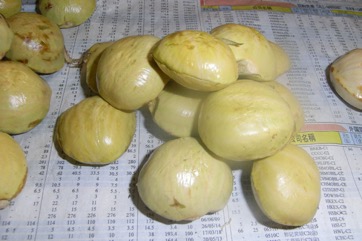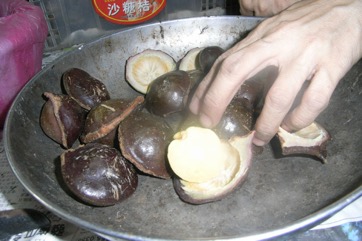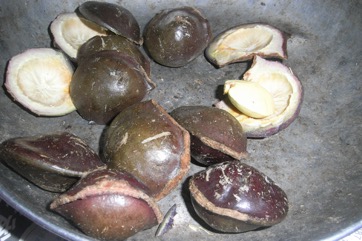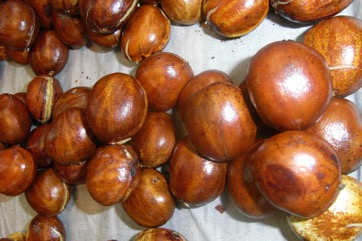Jengkol, Jiringa

A tropical plant. It grows in rainforest including re-growth. It can grow on sand or clay soils. It occurs from sea level up to 1,000 m altitude or sometimes 1600 m in Java.
Also known as:
Cha niang, Chanieng, Danyin, Dhinyindi, Jaring, Jering, Jing, Jiring, Jringkol, Kanieng, Ngapi nut, Niang, Niang-nok, Nieng, Tang-yin, Tanyeng-pen, Tanyin, Tutung, Yawng
Synonyms
- Albizia jiringa (Jack) Kurz.
- Albizia lucida auct. non (Roxb.) Benth.
- Feuillea jiringa (Jack) O Kuntze
- Inga bigemina auct. non (L.) Willd.
- Inga jiringa Jack ex DC.
- Inga kaeringa (Roxb.) Voigt
- Mimosa jiringa Jack
- Mimosa kaeringa Roxb.
- Pithocellobium jiringa (Jack) Prain
- Pithocellobium lobatum Benth.
- (part) Zygia jiringa (Jack) Kosterman.
Edible Portion
- Pods - flavouring, Shoots, Seeds, Spice, Leaves, Vegetable
Where does Jengkol grow?
Found in: Asia, Bangladesh, Brunei, Indochina, Indonesia, Malaysia, Myanmar, Pacific, Philippines, SE Asia, Thailand
Notes: The seeds can contain djenkol acid which is poisonous. There are 90 Archidendron species. Also as Mimosaceae.
Status: It is sold in Asian stores bottled in brine. It is a cultivated food plant. It is popular in SE Asia.
Growing Jengkol, Jiringa
Cultivation: The trees are grown from seed planted in the location where they are to grow. A spacing of 10-15 m is suitable.
Edible Uses: The seeds are also eaten raw and as a side dish with hot curry. Sometimes the water is changed. The seeds are boiled or roasted and eaten. They are used as a flavouring for food. The young shoots and pods are also eaten. A relish is made from thinly sliced nuts. They are also boiled or fried and used as a vegetable. It is also pounded flat, sun dried and deep fried. Caution: Excessive consumption of seeds can affect the kidneys.
Production: It flowers and fruits throughout the year. It takes 40-50 days from flowering to mature fruit. A mature tree produces 1,000-4,000 seeds per year.
Nutrition Info
per 100g edible portion| Edible Part | Energy (kcal) | Protein (g) | Iron (mg) | Vitamin A (ug) | Vitamin c (mg) | Zinc (mg) | % Water |
|---|---|---|---|---|---|---|---|
| Pods - flavour | 92 | 6.2 | 0.7 | - | - | - | 76.3 |
| Seeds - flavour | 22 | 3.5 | 0.7 | 72 | 12 | - | 93 |
| Shoots - flavour | - | - | - | - | - | - |
Jengkol, Jiringa Photos




References
Adansonia ser. 2, 19:32. 1979
Altschul, S.V.R., 1973, Drugs and Foods from Little-known Plants. Notes in Harvard University Herbaria. Harvard Univ. Press. Massachusetts. no. 1552 (As Zygia jiringa)
Argent, G et al, nd, Manual of the Larger and More important non Dipterocarp Trees of Central Kalimantan Indonesia. Volume 2 Forest Research Institute, Samarinda, Indonesia. p 352
Arora, R. K., 2014, Diversity in Underutilized Plant Species - An Asia-Pacific Perspective. Bioversity International. p 100, 108
Burkill, I.H., 1966, A Dictionary of the Economic Products of the Malay Peninsula. Ministry of Agriculture and Cooperatives, Kuala Lumpur, Malaysia. Vol 2 (I-Z) p 1792 (As Pithecellobium jiringa)
Coronel, R.E., 1982, Fruit Collections in the Philippines. IBPGR Newsletter p 8 (As Pithecellobium jiringa)
Food Composition Tables for use in East Asia FAO http://www.fao.org/infoods/directory No. 363 (As Pithecellobium jiringa)
Gardner, S., et al, 2000, A Field Guide to Forest Trees of Northern Thailand, Kobfai Publishing Project. p 162
Hedrick, U.P., 1919, (Ed.), Sturtevant's edible plants of the world. p 506 (As Pithecellobium lobatum)
G. King, J. Asiat. Soc. Bengal, Pt. 2, Nat. Hist. 66(2):267. 1897 (As Pithecellobium jiringa)
Jacquat, C., 1990, Plants from the Markets of Thailand. D.K. Book House p 40
Japanese International Research Centre for Agricultural Science www.jircas.affrc.go.jp/project/value_addition/Vegetables
Kiple, K.F. & Ornelas, K.C., (eds), 2000, The Cambridge World History of Food. CUP p 1792 (As Pithecellobium jiringa)
Lembogi Biologi Nasional, 1980, Sayur-sayuran. Balai Pustaka, Jakarta. p 34 (As Pithecellobium jiringa)
Macmillan, H.F. (Revised Barlow, H.S., et al) 1991, Tropical Planting and Gardening. Sixth edition. Malayan Nature Society. Kuala Lumpur. p 322
Martin, F. W., et al, 1987, Perennial Edible Fruits of the Tropics. USDA Handbook 642 p 35 (As Pithecellobium lobatum)
Menninger, E.A., 1977, Edible Nuts of the World. Horticultural Books. Florida p 99 (As Pithecellobium jiringa)
Menninger, E.A., 1977, Edible Nuts of the World. Horticultural Books. Florida p 99 (As Pithecellobium lobatum)
Milow, P., et al, 2013, Malaysian species of plants with edible fruits or seeds and their evaluation. International Journal of Fruit Science. 14:1, 1-27 (Also as Pithecellobium jiringa Prain)
Murakami, A. et al, 2014, Screening for the In Vitro Anti-tumor-promoting Activities of Edible Plants from Malaysia. Bioscience, Biotechnology, and Biochemistry, 64:1, 9-16.
Nakahara, K. et al, 2002, Antimutagenicity of Some Edible Thai Plants, and a Biocative Carbazole Alkaloid, Mahanine, Isolated from Micromelum minutum. Journal of Agricultural and Food Chemistry. 50: 4796-4892
Nielsen, 1992, Mimosaceae. Flora Malesiana ser 1, 11(1) p 106
Ochse, J.J. et al, 1931, Vegetables of the Dutch East Indies. Asher reprint. p 425 (As Pithecolobium lobatum)
Ong, H., et al, 2012, Traditional knowledge and usage of edible plants among the Semai community of Kampung Batu 16, Tapah, Perak, Malaysia. Scientific Research and Essays Vol. 7(4), pp. 441-445, 30 January, 2012
Ong, H.C. et al, 2012, Traditional knowledge and usage of edible plants among the Temuan villagers, Malaysia. Indian Journal of Traditional Knowledge. 11(1) pp 161-165
Pitojo, S., 1992, Jengkol. Budidaya dan pemanfaatannya. Pernerbit Kanisius. (As Pithecellobium jiringa)
PROSEA handbook Volume 13 Spices. p 274
Sakunpak, A. & Panichayupakaranant, P., 2012, Antibacterial activity of Thai edible plants against gastrointestinal pathogenic bacteria and isolation of a new broad spectrum antibacterial polyisoprenylated benzophenone, chamuangone. Food Chemistry 130 (2012) 826–831
Seidemann J., 2005, World Spice Plants. Economic Usage, Botany, Taxonomy. Springer. p 49
Shin, T., et al, 2018, Traditional knowledge of wild edible plants with special emphasis on medicinal uses in Southern Shan State, Myanmar. Journal of Ethnobiology and Ethnomedicine (2018) 14:48
Siemonsma, J. S. and Piluek, K. (Eds), 1994, Plant Resources of South-East Asia No. 8 Vegetables. Prosea Foundation, Bogor, Indonesia, p 89
Siong, K. H., 2003, Indigenous Fruits of Sarawak. ITTO & Sarawak Forest Department. p 80 (As Pithecellbium jiringa)
Slik, F., www.asianplant.net
Solomon, C., 2001, Encyclopedia of Asian Food. New Holland. p 247 (As Pithecellobium lobatum)
Sosef, M. S. M., Hong, L. T., & Prawirohatmodjo, S., (Eds.), 1998, Timber tree: Lesser-known timbers. Plant Resources of South-East Asia, 5(3), p 84
Suwardi, A. B., et al, 2020, Ethnobotany and conservation of indigenous edible fruit plants in South Aceh, Indonesia. Biodiversitas Vol. 21, No. 5, pp 1850-1860
Terra, G.J.A., 1973, Tropical Vegetables. Communication 54e Royal Tropical Institute, Amsterdam, p 67 (As Pithecellobium lobatum)
Thitiprasert, W., et al, 2007, Country report on the State of Plant Genetic Resources for Food and Agriculture in Thailand (1997-2004). FAO p 106
USDA, ARS, National Genetic Resources Program. Germplasm Resources Information Network - (GRIN). [Online Database] National Germplasm Resources Laboratory, Beltsville, Maryland. Available: www.ars-grin.gov/cgi-bin/npgs/html/econ.pl (10 April 2000)
World Checklist of Useful Plant Species 2020. Royal Botanic Gardens, Kew
Zawiah, N. & Othaman, H., 2012, 99 Spesies Buah di FRIM. Institut Penyelidikan Perhutanan Malaysia. p 28
Wickens, G.E., 1995, Edible Nuts. FAO Non-wood forest products. FAO, Rome. p 141 (As Pithecellobium jiringa)